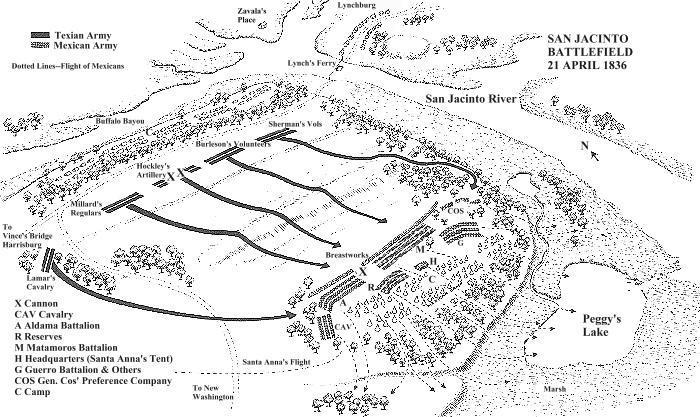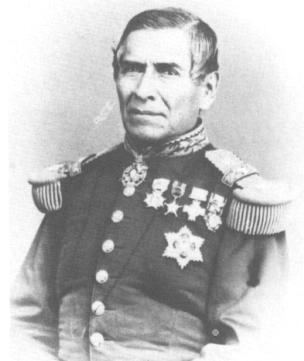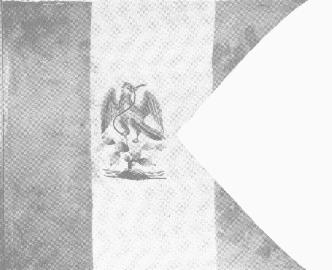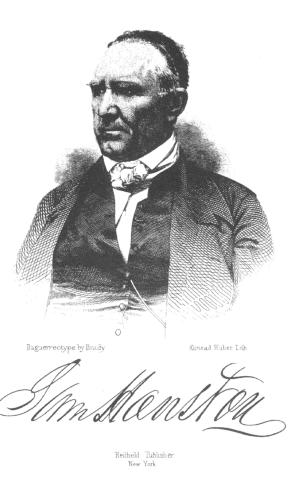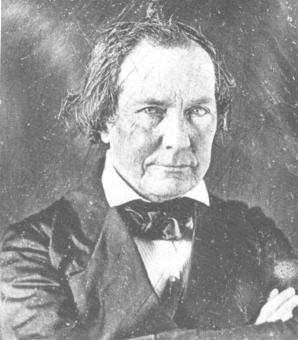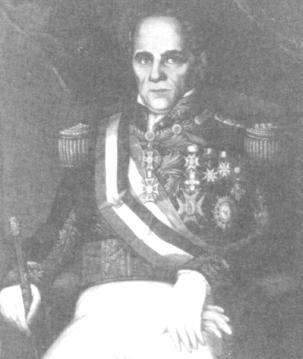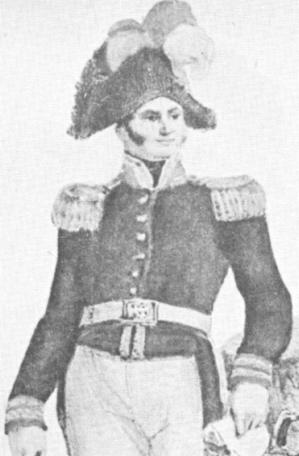SONS OF DEWITT COLONY TEXAS Campsites
of the Texian Army ".........waving his hat and shouting "San Jacinto! San Jacinto! The Mexicans are whipped and Santa Anna a prisoner." The scene that followed beggars description. People embraced, laughed and wept and prayed, all in one breath. As the moon rose over the vast flower-decked prairie, the soft southern wind carried peace to tired hearts and grateful slumber. As battles go, San Jacinto was but a skirmish; but with what mighty consequences! The lives and the liberty of a few hundred pioneers at stake and an empire won! Look to it, you Texans of today, with happy homes, mid fields of smiling plenty, that the blood of the Alamo, Goliad, and San Jacinto sealed forever . Texas, one and indivisible!--Ms. Kate Scurry Terrell describing the scene among refugee families on the Sabine River. More biographical information:
SAN JACINTO, birthplace of Texas liberty! ... San Jacinto, one of the world’s decisive battles! . . . San Jacinto, where, with cries of "Remember the Alamo! Remember Goliad!" Sam Houston and his ragged band of 910 pioneers routed Antonio Lopez de Santa Anna, President and Dictator of Mexico and self-styled "Napoleon of the West," with his proud army, and changed the map of North America! Here is a story that has thrilled Texans for more than a century ... a story of desperate valor and high adventure; of grim hardship, tragedy and romance ... the story of the epochal battle that established the independent Lone Star Republic, on April 21, 1836, and indelibly inscribed the names of Texas patriots on history's scroll of American immortals. The actual battle of San Jacinto lasted less than twenty minutes, but it was in the making for six years. It had its prelude in the oppressive Mexican edict of April 6, 1830, prohibiting further emigration of Anglo-Americans from the United States to Texas; in the disturbance at Anahuac and in the battle of Velasco, in 1832; in the imprisonment of Stephen F. Austin, the "Father of Texas," in Mexico in 1834. Immediate preliminaries were the skirmish over a cannon at Gonzales; the capture of Goliad; the "Grass Fight," and the siege and capture of San Antonio . . . all in 1836. The Texas Declaration of Independence at Washington-on-the-Brazos on March 2, 1836, officially signalized the revolution. Four days after the Declaration of Independence, news came to the convention on the Brazos of the desperate plight of Colonel William Barret Travis, under siege at the Alamo in San Antonio. Sam Houston, commander-in-chief of the Texas Army, left Washington post-haste for Gonzales, to, take command of the troops there and go to the aid of Travis. He arrived there on the 11th, and at about dark learned from two Mexicans who had just arrived from San Antonio that the Alamo had fallen and its 183 brave defenders massacred. This was confirmed two days later by Mrs. Almeron Dickinson who had been released by the Mexicans after seeing her lieutenant husband killed in the old mission. She was trudging toward Gonzales with her babe in her arms when the Texas army scouts found her. The reports of the Alamo slaughter terrified the people of Gonzales. They were panic-stricken by the general belief that Santa Anna next would sweep eastward with his well-trained army, in a drive to wipe the rebellious Texans from the face of the earth. Then began the exodus of frantic colonists known to Texas history as the "Runaway Scrape." Men, women and children packed what belongings they could take in wagons and carts, on horseback, or on their own backs, and fled their homes in terror across the rain soaked country . . . all moving eastward toward the Louisiana border to escape the wrath of the bloodthirsty Santa Anna.
THE MEXICAN PURSUIT
THE ROAD TO SAN JACINTO Meanwhile, on April 11th, the Texans at Groce's received two cannon, known to history as the "Twin Sisters," a gift from citizens of Cincinnati, Ohio. Thus fortified, General Houston, after a consultation with Rusk, decided to move on to the east side of the Brazos. The river being very high, the steamboat "Yellow Stone" and a yawl were used to ferry the army, horses, cattle and baggage across. The movement began on the 12th and was completed at 1 p.m. on the 13th. On the 13th Houston ordered Major Wyly Martin, Captain Mosely Baker, and other commanders of detachments assigned to delaying actions, to rejoin the main army at the house of Charles Donoho, about three miles from Groce's. At Donoho's the road from San Felipe to eastern Texas crossed the road south from Groce's. On April 16 the army marched twelve miles to the home of Samuel McCurley on Spring Creek, in present Harris county. The creeks formed the boundary line between Harris and Montgomery counties. Three miles beyond McCurley's was the home of Abram Roberts, at a settlement known as "New Kentucky." At Roberts' two wagon trails crossed, one leading to Harrisburg and the other Robbins' Ferry on the Trinity and on to the Sabine. Many of his officers and men, as well as government officials, believed that Houston's strategy was to lead the pursuing Mexicans to the Sabine River, the eastern border of Texas. There, it was known, were camped United States troops under General Pendelton Gaines, with whose help the Texans might turn on their foes and destroy them. However, on April 17, when Roberts' place was reached, Houston took the Harrisburg road instead of the one toward the Louisiana line, much to the gratification of his men. They spent the night of the 17th near the home of Matthew Burnett on Cypress Creek, twenty miles from McCurley's. On April 18 the army marched twenty miles to White Oak Bayou in the Heights District of the present city of Houston, and only about eight miles from Harrisburg, now a part of Houston.
In a letter to Henry Raguet he said: "This morning we are in preparation to meet Santa Anna. It is the only chance for saving Texas." In an address "To the People of Texas" he wrote: "We view ourselves on the eve of battle. We are nerved for the contest, and must conquer or perish…We must act now or abandon all hope." Houston's force crossed Buffalo Bayou to the west side, near the home of Isaac Batterson, two and a half miles below Harrisburg, on the evening of the 19th. Some 248 men, mostly sick and non-effective, were left with the baggage at the camp opposite Harrisburg. The march was continued until midnight. ON THE EVE OF BATTLE At dawn April 20 the Texans resumed their trek down the bayou, to intercept the Mexicans. At Lynch's ferry, near the juncture of Buffalo Bayou and San Jacinto River, they captured a boat laden with supplies for Santa Anna. This probably was some of the plunder of Harrisburg or New Washington. Ascertaining that none of the enemy forces had crossed, the Texans drew back about a mile on the Harrisburg road, and encamped in a skirt of timber protected by a rising ground.
Santa Anna's blue-uniformed army made camp under the high ground overlooking a marsh, about three-fourths of a mile from the Texas camp. They threw up breastworks of trunks, baggage, pack-saddles and other equipment. Both sides prepared for the expected conflict. The Texans awoke to find Thursday, April 21, a clear fine day. Refreshed by a breakfast of bread made with flour from the captured supplies and meat from beeves slaughtered the day before, they were eager to attack the enemy. They could see Santa Anna's flags floating over the enemy camp, and heard the Mexican bugle calls on the crisp morning air. It was discovered at about nine o'clock that General Martín Perfecto de Cos had crossed Vince's bridge, about eight miles behind the Texans' camp, with some 540 picked troops, swelling the enemy forces to about 1265. General Houston ordered "Deaf" Smith and a detail to destroy the bridge and prevent further enemy reinforcements. This also would prevent the retreat of either the Texans or the Mexicans toward Harrisburg. In dry weather Vince's Bayou was about fifty feet wide and ten feet deep, but the excessive April rains bad made it several times wider and deeper. [With "Deaf" Smith in the detail that destroyed the bridge were Young P. Alsbury, John Coker, John Garner, Moses Lapham, Edwin R. Rainwater and Dimer W. Reaves.]
THE BATTLE OF SAN JACINTO General Houston disposed his forces in battle order at about 3:30 in the afternoon. Over on the Mexican side all was quiet; many of the foemen were enjoying their customary siesta. The Texans' movements were screened by the trees and the rising ground, and evidently Santa Anna had no lookouts posted. Big, shaggy and commanding in his mud-stained unmilitary garb, the chieftain rode his horse up and down the line. "Now hold your fire, men," he warned in his deep voice, "until you get the order!"
The Battlefield of San
Jacinto
Silently and tensely the Texas battle line swept across the prairie and swale that was No Man's land, the men bending low. A soldier's fife piped up with "Will You Come to the Bower,"' a popular tune of the day. That was the only music of the battle. [Several veterans of the battle said the tune played was "Yankee Doodle."] As the, troops advanced, "Deaf" Smith galloped up and told Houston, "Vince's bridge has been cut down." The General announced it to the men. Now both armies were cut off from retreat in all directions but one, by a roughly circular moat formed by Vince's and Buffalo Bayous to the west and north, San Jacinto River to the north and cast, and by the marshes and the bay to the east and southeast. At close range, the two little cannon, drawn by rawhide thongs, were wheeled into position and belched their charges of iron slugs into the enemy barricade. Then the whole line, led by Sherman's men, sprang forward on the run, yelling, "Remember the Alamo!" "Remember Goliad!" All together they opened fire, blazing away practically point-blank at the surprised and panic-stricken Mexicans. They stormed over the breastworks, seized the enemy's artillery, and joined in hand-to-hand combat, emptying their pistols, swinging their guns as clubs, slashing right and left with their knives. Mexicans fell by the scores under the impact of the savage assault. General Manuel Fernández Castrillón, a brave Mexican, tried to rally the swarthy Latins, but he was killed and his men became crazed with fright. Many threw down their guns and ran; many wailed, "Me no Alamo!" "Me no Goliad!" But their pleas won no mercy. The enraged revolutionists reloaded and chased after the stampeding enemy, shooting them, stabbing them, clubbing them to death. From the moment of the first collision the battle was a slaughter, frightful to behold. The fugitives ran in wild terror over the prairie and into the boggy marshes, but the avengers of the Alamo and Goliad followed and slew them, or drove them into the waters to drown. Men and horses, dead and dying, in the morass in the rear and right of the Mexican camp, formed a bridge for the pursuing Texans. Blood reddened the water. General Houston tried to check the execution but the fury of his men was beyond restraint. Some of the Mexican cavalry tried to escape over Vince's bridge, only to find that the bridge was gone. In desperation, some of the flying horsemen spurred their mounts down the steep bank; some dismounted and plunged into the swollen stream. The Texans came up and poured a deadly fire into the welter of Mexicans struggling with the flood. Escape was virtually impossible. General Houston rode slowly from the field of victory, his ankle shattered by a rifle ball. At the foot of the oak where he bad slept the previous night be fainted and slid from his horse into the arms of Major Hockley, his chief of staff.
It is interesting to compare the accounts of the battle of San Jacinto written by leaders of the opposing Texan and Mexican forces. Report of Secretary of War Thomas J. Rusk.
[Headquarters of the Army, San Jacinto, April 25, 1836.---Sir I regret extremely that my situation since the battle of the 21st has been, such as to prevent my rendering you my official report of the same previous to this. I have the honor to inform you that on the evening of the 18th, after a forced march of fifty-five miles, which was effected in two days and a half, the army a: rived opposite Harrisburg. That evening a courier of the enemy was taken, from whom I learned that General Santa Anna, with one division of his choice troops, had marched in the direction of Lynches Ferry, on the San Jacinto, burning Harrisburg as he passed down. The army was ordered to be in readiness to march the next morning. The main body effected a crossing over Buffalo Bayou below Harrisburg, on the morning of the 19th, having left the baggage, the sick and a sufficient guard in the rear. We continued the march throughout the night, making but one halt in the prairie for a short time and without refreshment. At daylight we resumed the line of march, and in a short distance our scouts encountered those of the enemy, and we received the information that General Santa Anna was at New Washington and would that day take up the line of march for Anahuac, crossing at Lynches Ferry. The Texas army halted within half a mile of the ferry in some timber, and were engaged in slaughtering beeves, when the army of Santa Anna was discovered to be approaching in battle array, having been encamped at Klopper's Point, eight miles below. Disposition was immediately made of our forces and preparation for his reception. He took a position with his infantry and artillery in the center, occupying an island of timber, his cavalry covering the left flank. The artillery, consisting of one double fortified medium brass twelve-pounder, then opened on our encampment. The infantry in column advanced with the design of charging our lines, but were repulsed by a discharge of grape and canister from our artillery, consisting of two six-pounders. The enemy had occupied a piece of timber within rifle shot of the left wing of our army, from which an occasional interchange of small arms took place between the troops, until the enemy withdrew to a position on the bank of the San Jacinto, about three-quarters of a mile from our encampment and commenced fortifications. A short time before sunset our mounted men, about eighty-five in number, under the special command of Colonel Sherman, marched out for the purpose of reconnoitering the enemy. While advancing they received a volley from the left of the enemy's infantry, and after a sharp re-encounter with their cavalry, in in which ours acted extremely well and performed some feats of daring chivalry, they retired in good order, having had two men severely wounded and several horses killed. In the meantime the infantry, under command of Lieutenant Colonel Millard, and Colonel Burleson's regiment, with the artillery, had marched out for the purpose of covering the retreat of the cavalry if necessary. All then fell back in good order to our encampment about sunset and remained without any ostensible action until the 21st, about 8:30 o'clock, taking the first refreshment which they had enjoyed for two days. The enemy in the meantime extended the right flank of their infantry so as to occupy the extreme point of a skirt of timber on the bank of the San Jacinto, and secured their left by a fortification about five feet high, constructed of packs and baggage, leaving an opening in the center of the breastwork in which their artillery was placed, their cavalry upon their left wing.] and then said: "About nine o'clock on the morning of the 21st, the enemy were reinforced by 500 choice troops, under the command of General Cos, increasing their effective force to upward of 1500 men, whilst our aggregate force for the field numbered 783. At half-past three o'clock in the evening, I ordered the officers of the Texian army to parade their respective commands, having in the meantime ordered the bridge on the only road communicating with the Brazos, distant eight miles from the encampment, to be destroyed-thus cutting off all possibility of escape. Our troops paraded with alacrity and spirit, and were anxious for the contest. Their conscious disparity in numbers seemed only to increase their enthusiasm and confidence, and heightened their anxiety for the conflict. Our situation afforded me an opportunity of making the arrangements Preparatory to the attack without exposing our designs to the enemy. The first regiment, commanded by Colonel Burleson, was assigned to the center. The second regiment, under the command of Colonel Sherman, formed the left wing of the army. The artillery, under special command of Colonel George W. Hockley, Inspector General, was placed on the right of the first regiment; and four companies of infantry, under the command of Lieut.Col. Henry Millard, sustained the artillery upon the right. Our cavalry, 61 in number, commanded by Colonel Mirabeau B. Lamar (whose gallant and daring conduct on the previous day had attracted the admiration of his comrades), completed our line. Our cavalry was first dispatched to the front of the enemy's left, for the purpose of attracting their notice, whilst an extensive island of timber afforded its an opportunity of concentrating our forces, and deploying from that point, agreeably to the previous design of the troops. Every evolution was performed with alacrity, the whole advancing rapidly in line, and through an open Prairie, without any protection whatever for our men. The artillery advanced and took station within 200 yards of the enemy's breastwork, and commenced an effective fire with grape and canister.
MEXICAN VERSION OF BATTLE
"At two o'clock in the afternoon of April 21, 1836, 1 had fallen asleep in the shade of an oak, hoping the beat would moderate so that I might begin the march, (to find Filisola), when the filibusterers surprised my camp with admirable skill. Imagine my surprise, on opening my eyes, and finding myself surrounded by those people, threatening me with, their rifles and overpowering my person. The responsibility of Filisola was obvious, because be and only he had caused such a catastrophe by his criminal disobedience." This is somewhat at variance with an earlier report, in which Santa Anna recounted his own heroic efforts to rally his troops in the battle until "the new recruits threw everything into confusion, breaking their ranks and preventing veterans from making use of their arms, whilst the enemy was rapidly advancing with loud hurrahs, and in a few minutes obtained a victory which they could not some hours before, even have dreamed of." Then, El Presidente went on:
Colonel Pedro Delgado, of Santa Anna's staff, gave a more detailed and more accurate Mexican version of the battle. He told how Santa Anna, his staff and most of the men were asleep when the bugler sounded the alarm of the Texan advance. Some of the men were out gathering boughs for shelter; cavalrymen were riding bareback, to and from water. Continuing:
In a grove on the bayshore, Colonel Delgado said, the Texans wrought the worst carnage of the battle.
Louis Wiltz Kemp was a noted historian and writer, an expert on the Battle of San Jacinto and instrumental in establishment of the San Jacinto Park and Museum. He served as vice-president of the San Jacinto Museum of History Association when this booklet, an autographed copy in possession of the author, was written in 1947. He also wrote The Signers of the Texas Declaration of Independence, an extensive bibliography of all the signers, and other works giving insight into the lives of the men who contributed to Texas Independence. Ed Kilman was also a noted Texas author and historian--Wallace L. McKeehan, Sons of DeWitt Colony Texas. SONS OF DEWITT COLONY TEXAS |
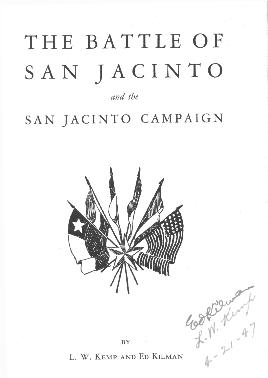 FOREWORD
FOREWORD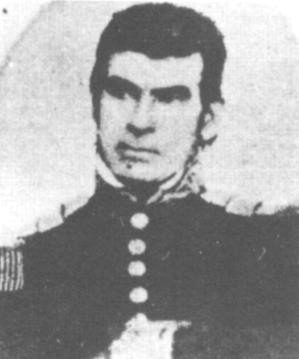 General Houston, realizing that his few hundred green
troops were no match for the well-drilled hordes from Mexico,
General Houston, realizing that his few hundred green
troops were no match for the well-drilled hordes from Mexico, 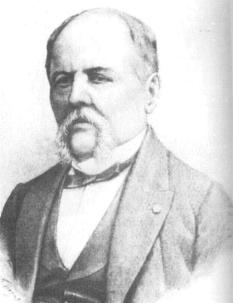 Flushed with their Alamo victory, the Mexican forces
were following the colonists. Houston's scouts reported that General Ramirez y
Sesma and
Flushed with their Alamo victory, the Mexican forces
were following the colonists. Houston's scouts reported that General Ramirez y
Sesma and 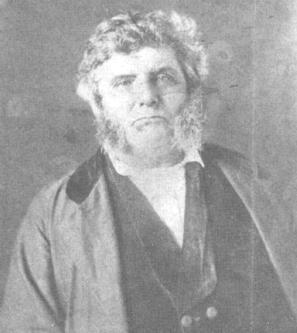 When the ad interim Texas government at
Washington-on-the-Brazos learned of the Mexicans' approach,
in mid-March, it fled to Harrisburg.
When the ad interim Texas government at
Washington-on-the-Brazos learned of the Mexicans' approach,
in mid-March, it fled to Harrisburg. 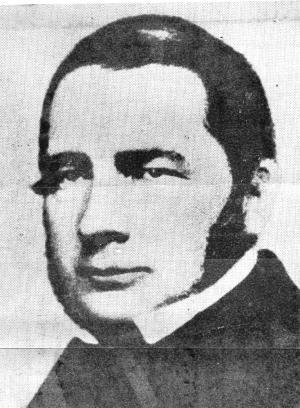 Santa Anna arrived at Harrisburg on the 15th. There he
learned that the Burnet government had gone down Buffalo Bayou to New Washington (now
Morgan's Point), about 18 miles southeast. Burning Harrisburg, Santa Anna sped after them.
On the 19th when he arrived at New Washington he learned that the new Texas government had
fled to Galveston. Santa Anna then set out for Anahuac via Lynchburg.
Santa Anna arrived at Harrisburg on the 15th. There he
learned that the Burnet government had gone down Buffalo Bayou to New Washington (now
Morgan's Point), about 18 miles southeast. Burning Harrisburg, Santa Anna sped after them.
On the 19th when he arrived at New Washington he learned that the new Texas government had
fled to Galveston. Santa Anna then set out for Anahuac via Lynchburg.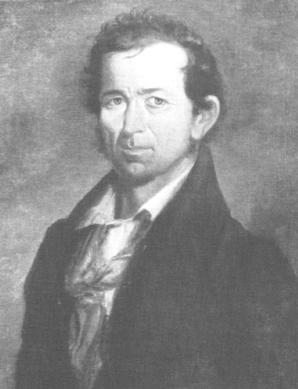 From two prisoners, captured by
From two prisoners, captured by 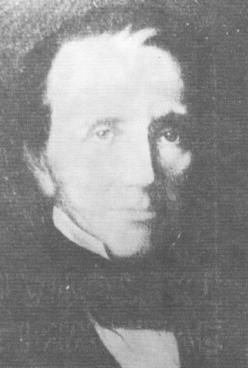

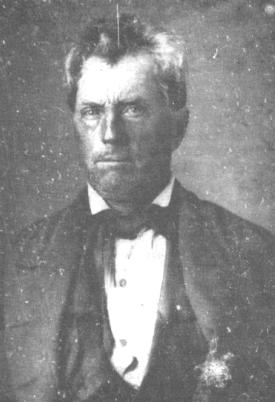 At the command, "Advance,"
the patriots, 910 strong, moved quickly out of the woods and over the rise, deploying.
Bearded and ragged from forty days in the field, they were a fierce-looking band. But
their long rifles were clean and well oiled. Only one company, Captain William Wood's "Kentucky
Rifles," originally recruited by Sidney Sherman, wore uniforms. [In
his official report of the battle, April 25, 1836, Houston said 783 Texans took part. Yet
in a roster published later he listed 845 officers and men at San Jacinto, and by
oversight omitted Captain Alfred H. Wyly's Company. In a Senate speech February 28, 1859,
Houston said his effective force never exceeded 700 at any point. Conclusive evidence in
official records brings the total number at San Jacinto up to 910.] The battle line
was formed with Edward Burleson's (photo left) regiment in the
center; Sherman's on the left wing; the artillery, under George W. Hockley, on Burleson's
right; the infantry, under Henry Millard, on the right of the artillery; and the cavalry,
led by Lamar, on the extreme right
At the command, "Advance,"
the patriots, 910 strong, moved quickly out of the woods and over the rise, deploying.
Bearded and ragged from forty days in the field, they were a fierce-looking band. But
their long rifles were clean and well oiled. Only one company, Captain William Wood's "Kentucky
Rifles," originally recruited by Sidney Sherman, wore uniforms. [In
his official report of the battle, April 25, 1836, Houston said 783 Texans took part. Yet
in a roster published later he listed 845 officers and men at San Jacinto, and by
oversight omitted Captain Alfred H. Wyly's Company. In a Senate speech February 28, 1859,
Houston said his effective force never exceeded 700 at any point. Conclusive evidence in
official records brings the total number at San Jacinto up to 910.] The battle line
was formed with Edward Burleson's (photo left) regiment in the
center; Sherman's on the left wing; the artillery, under George W. Hockley, on Burleson's
right; the infantry, under Henry Millard, on the right of the artillery; and the cavalry,
led by Lamar, on the extreme right 